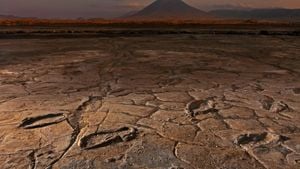Researchers have turned to Australian sea lions as unexpected allies in mapping uncharted ocean habitats, utilizing camera technology attached to the marine mammals. The initiative allows scientists to gain insights about the seabed and the diverse ecosystems where these animals thrive.
The project has seen eight adult female sea lions equipped with small, lightweight cameras and GPS loggers affixed to their fur. This technique enables the sea lions to access areas unreachable by conventional survey vessels, presenting researchers with distinct footage.
According to Nathan Angelakis, a PhD student at the University of Adelaide and South Australian Research and Development Institute (SARDI), the experiment aims to reveal previously unmapped habitats at the ocean's floor. Animal-borne video data can comprehensively cover vast territories, offering critical information about diverse marine environments.
During their dives, the sea lions captured around 89 hours of video footage, highlighting various habitats within 5,000 square kilometers of southern Australia’s seabed. Their recordings have revealed the presence of six distinct benthic habitats, showcasing the ecological riches lying beneath the waves.
The cameras, which weighed less than one percent of the sea lions' body weight, were cleverly attached using neoprene, ensuring minimal disruption to the animals’ movement. This blend of innovation and wildlife expertise has opened new doors to marine mapping.
The research, which is detailed in the journal Frontiers, underscores the significance of marine biodiversity and how it can be better understood through unexpected means. The findings indicate the presence of habitats like lush kelp forests, sponge gardens, and sandy plains, which are critical not only for sea lions but also for other marine species.
Angelakis pointed out, "The sea lions explored unmapped areas of the ocean, found new reefs, and revealed amazing diverse habitats on the seafloor. This information will be critical for conserving and managing their populations going forward."
The Australian sea lion population has faced significant challenges, with numbers declining by over 60% during the past four decades. These insights gleaned from the project may help catalyze efforts aimed at conservation and habitat protection.
Often, mapping and studying the ocean floor can be tricky and resource-intensive, reliant on expensive equipment or conditions often challenged by weather. The clever use of sea lions is both cost-effective and practical, showcasing how wildlife can contribute to scientific research.
The unique footage captured during the project not only reflects the sea lions’ hunting habits but also reveals their individual preferences for prey—some enjoying cod, others seeming to favor cuttlefish. This level of detail offers exciting potential for future studies on marine predator behavior and habitat interaction.
Efforts like this bridge the gap between technology and conservation, employing animal behavior as the key to unlocking secrets of the ocean floor. Charismatic megafauna such as sea lions are proving to be valuable participants, even as they struggle within the changing tides of their ecosystems.
Through this method, researchers are attempting to deepen their knowledge of how various seabed habitats function, especially as human activity increasingly impacts these ecosystems. Understanding these dynamics is fundamental for the protection and sustainability of marine environments.
The sea lions' role has underscored the capabilities of wildlife as effective tools for research, pushing the boundaries of traditional oceanography. By watching the world through their eyes, scientists can gather critical information, all thanks to these agile underwater companions.
This study is not just about gathering data; it is about cultivating hope for endangered species amid alarming statistics. By embracing innovative research methods, the hope is to forge pathways toward conservation success.
With technology intertwining with nature, the expedition symbolizes how collaborative efforts can yield fruitful results for conservation efforts. The data derived from the sea lions will not only shape policies related to their management but may also protect other key marine species sharing their habitats.
Angelakis concluded, "Improving our knowledge about how seafloor habitats are affected by human activity is imperative. If we accurately reflect on these environments, we stand a chance at protecting them for future generations."
The integration of wildlife and technology through this initiative is paving the way for groundbreaking advances. Sea lions are not just stunning spectacles; they have become pivotal players in the quest to understand the vast biological libraries of our oceans.



